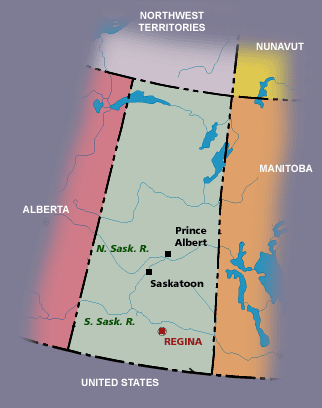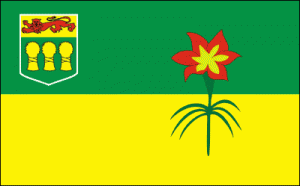Saskatchewan
Pray:
- Pray for the Aglow groups and leaders to be strengthened.
- Pray for all the resources and creativity needed to fulfill the intentions of God in the province of Saskatchewan.
- Pray for the Aglow prayer group in the Capital city.
- Pray for godly government leaders. Blessed is the nation whose God is The Lord, the people whom He has chosen for His own inheritance. Psalm 33:12
Proclaim:
- Arise, shine; for your light has come! And the glory of the LORD is risen upon you. For behold, the darkness shall cover the earth, and deep darkness the people; but the LORD will arise over you, and His glory will be seen upon you. Isaiah 60:1,2 (NKJV)
- Lift up your heads, O you gates! Lift up, you everlasting doors! And the King of glory shall come in. Who is this King of glory? The Lord of hosts, He is he King of glory. Psalm 24:9-10 (NKJV)
Interesting Facts About Saskatchewan
Government: The province of Saskatchewan has a parliamentary form of government. The chief executive of Saskatchewan is the lieutenant governor, who is appointed by the Canadian governor-general in council to serve a 5-year term. The lieutenant governor, representing the British crown, holds a position that is largely honorary.
The premier, the leader of the majority party, is the actual head of the provincial government and presides over the executive council. The Legislative Assembly contains 58 seats, including those of the premier and the members of the executive council. Members of the legislature are popularly elected to a 5-year term; however, the lieutenant governor, on the advice of the premier, may call for an election before the term has been completed.
6 senators appointed by the Canadian governor-general in council and by 14 members in the House of Commons popularly elected to serve terms of up to five years in the Canadian Parliament represent the province of Saskatchewan.
People: In the early 1880’s, there were fewer than 1,000 non-Aboriginal people in the area that was to become the province of Saskatchewan. Ten years later 20,000 people occupied the territory, mostly settlers from Ontario. With the Canadian government’s aggressive National Policy immigrants from many European countries came in to settle the land over the next thirty years. The government’s efforts to promote immigration and encourage agricultural development between the 1890s and the 1920s increased the Saskatchewan population to almost a million by 1920. Through the middle of the twentieth century the population grew slowly, however after World War II, the pattern changed as refugees from Europe came to find a new home.
Descendents of English or French immigrants do not make up the majority of the population of Saskatchewan. The population is diverse with roots in the waves of agricultural immigrants who came at the time of the opening up of the province in the 1890’s – 1920’s. Waves of Ukrainian, Russia, Scandinavia and immigrants from the British Isles settled the rural areas and developed the agricultural base. Although the province is dependent on the farm economy, two-thirds of its people live in the cities and towns. The population is split 63 percent urban, 37 per cent rural, There are 12 cities, 146 towns, 376 villages and 297 rural municipalities in Saskatchewan.
History: The name Saskatchewan originated with the Plains Indians. Their word was “kisiskatchewan”- meaning the river that flows swiftly – in reference to the most important waterways running through their territory, the North and South Saskatchewan Rivers. The Canadian plains have long been home to Aboriginal people. The earliest European to enter the area was Henry Kelsey, a Hudson’s Bay Company agent, who followed the Saskatchewan River into the southern plains of Saskatchewan in about 1690.
In the mid nineteenth century British geological and botanical expeditions led by Henry Youle Hind and John Palliser went into the North West. They found an abundance of resources, and assessed that parts of the plains region were suitable for farming, and other activities. In 1867 the new Canadian government, purchased Rupert’s Land (the North West Territories) from the Hudson’s Bay Company. After the Red River Insurrection of 1869 – 70 and the Province of Manitoba entering Confederation the lands of present day Saskatchewan and Alberta were administered as Territories. After the exile of Manitoba Métis leader Louis Riel from the Dominion of Canada, disillusioned Métis (mixed blood aboriginals) began arriving in significant numbers from Manitoba and settling along the South Saskatchewan River.
The Canadian government established Treaties with the aboriginal population promising support for the giving up of their lands and settlers began to move into the newly opened lands. A proposed transcontinental railway, the CPR, was to traverse the agricultural lands however in 1883 it was moved south along the arid southern belt parallel to the US border.
The early 1880’s were a time of great concern on the Canadian prairie. The aboriginal people on their ‘reservations” were starving and freezing to death, the Métis were concerned that they would not receive title to their lands and the promised railway was no longer coming to support the farmers and settlers. Once again the people of the west were in crisis. They called on Louis Riel, the leader of the Métis and the man who had brought Manitoba into Confederation, to assist them in this crisis. After eight months of constitutional negotiations armed conflict broke out in March 1885. Five thousand Canadian troops were sent west and the ‘rebellion’ was put down. Louis Riel and eight Indian leaders were executed.
With the arrival of the railway in 1885, a new immigrant population of farmers and settlers started to grow. In the early years of the twentieth century the population swelled with the discovery of new strains of wheat suited to the short growing season and the harsh climate of the Canadian Prairies.
On September 1, 1905, Saskatchewan became a province of Canada with Regina as its capital city. By 1925 Saskatchewan had the highest per capita income in the world. The 1929 economic crash, combined with a decade of drought and bad harvests, brought the lean years of the Great Depression to the province. The recovery of the 1940s and 1950s saw the economy, once dependent solely on agriculture, become more diversified with the development of oil, uranium, potash, coal and other minerals.
Interesting Facts information from the library.educationworld.net/canadafacts website. Read more about Saskatchewan


